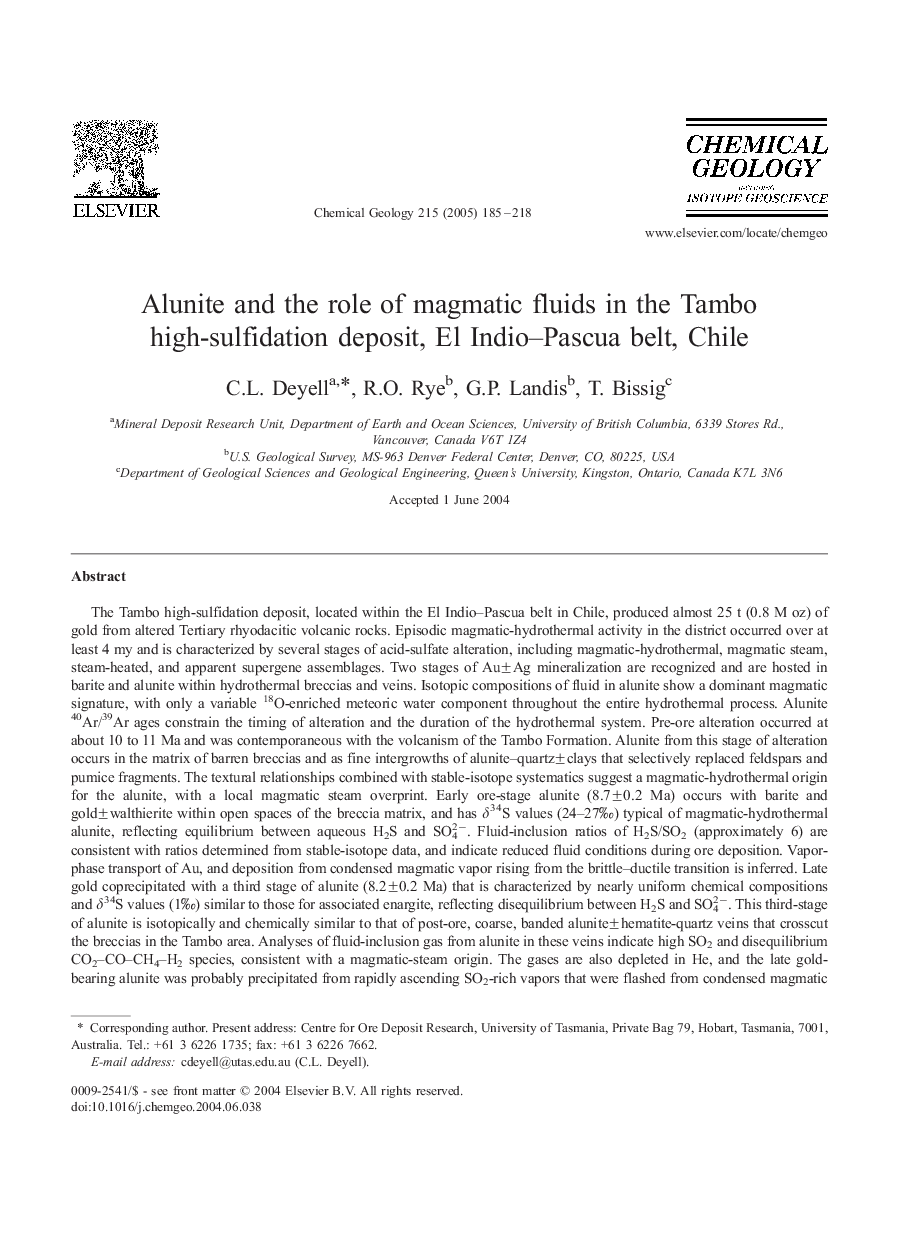| کد مقاله | کد نشریه | سال انتشار | مقاله انگلیسی | نسخه تمام متن |
|---|---|---|---|---|
| 9529213 | 1637793 | 2005 | 34 صفحه PDF | دانلود رایگان |
عنوان انگلیسی مقاله ISI
Alunite and the role of magmatic fluids in the Tambo high-sulfidation deposit, El Indio-Pascua belt, Chile
دانلود مقاله + سفارش ترجمه
دانلود مقاله ISI انگلیسی
رایگان برای ایرانیان
کلمات کلیدی
موضوعات مرتبط
مهندسی و علوم پایه
علوم زمین و سیارات
ژئوشیمی و پترولوژی
پیش نمایش صفحه اول مقاله

چکیده انگلیسی
The Tambo high-sulfidation deposit, located within the El Indio-Pascua belt in Chile, produced almost 25 t (0.8 M oz) of gold from altered Tertiary rhyodacitic volcanic rocks. Episodic magmatic-hydrothermal activity in the district occurred over at least 4 my and is characterized by several stages of acid-sulfate alteration, including magmatic-hydrothermal, magmatic steam, steam-heated, and apparent supergene assemblages. Two stages of Au±Ag mineralization are recognized and are hosted in barite and alunite within hydrothermal breccias and veins. Isotopic compositions of fluid in alunite show a dominant magmatic signature, with only a variable 18O-enriched meteoric water component throughout the entire hydrothermal process. Alunite 40Ar/39Ar ages constrain the timing of alteration and the duration of the hydrothermal system. Pre-ore alteration occurred at about 10 to 11 Ma and was contemporaneous with the volcanism of the Tambo Formation. Alunite from this stage of alteration occurs in the matrix of barren breccias and as fine intergrowths of alunite-quartz±clays that selectively replaced feldspars and pumice fragments. The textural relationships combined with stable-isotope systematics suggest a magmatic-hydrothermal origin for the alunite, with a local magmatic steam overprint. Early ore-stage alunite (8.7±0.2 Ma) occurs with barite and gold±walthierite within open spaces of the breccia matrix, and has δ34S values (24-27â°) typical of magmatic-hydrothermal alunite, reflecting equilibrium between aqueous H2S and SO42â. Fluid-inclusion ratios of H2S/SO2 (approximately 6) are consistent with ratios determined from stable-isotope data, and indicate reduced fluid conditions during ore deposition. Vapor-phase transport of Au, and deposition from condensed magmatic vapor rising from the brittle-ductile transition is inferred. Late gold coprecipitated with a third stage of alunite (8.2±0.2 Ma) that is characterized by nearly uniform chemical compositions and δ34S values (1â°) similar to those for associated enargite, reflecting disequilibrium between H2S and SO42â. This third-stage of alunite is isotopically and chemically similar to that of post-ore, coarse, banded alunite±hematite-quartz veins that crosscut the breccias in the Tambo area. Analyses of fluid-inclusion gas from alunite in these veins indicate high SO2 and disequilibrium CO2-CO-CH4-H2 species, consistent with a magmatic-steam origin. The gases are also depleted in He, and the late gold-bearing alunite was probably precipitated from rapidly ascending SO2-rich vapors that were flashed from condensed magmatic fluids located below the brittle-ductile transition. Alunite-huangite veins (8.6±0.4 Ma) were formed intermediate to the two mineralizing events. Steam-heated alunite (8.9±0.4 Ma), derived from the oxidation of H2S within the vadose zone, is preserved at the highest elevations and overlaps with Stage 2 ore deposition. Post-mineral alunite±jarosite (7.3±0.1 Ma) occurs as apparent supergene crosscutting veins and overgrowths. Stable-isotope data, however, indicate a strong magmatic component to both near-surface and late-stage alunite-forming fluids. This dominant magmatic fluid signature at high levels during the waning stages of hydrothermal activity is attributed to climatic and physiographic conditions specific to the El Indio-Pascua belt during the Middle to Late Miocene.
ناشر
Database: Elsevier - ScienceDirect (ساینس دایرکت)
Journal: Chemical Geology - Volume 215, Issues 1â4, 15 February 2005, Pages 185-218
Journal: Chemical Geology - Volume 215, Issues 1â4, 15 February 2005, Pages 185-218
نویسندگان
C.L. Deyell, R.O. Rye, G.P. Landis, T. Bissig,